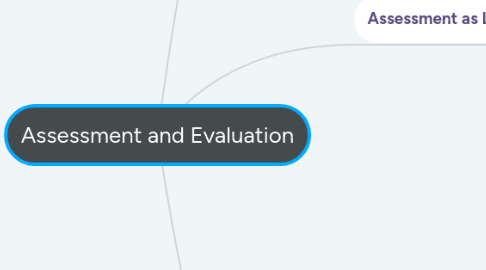
1. Assessment for Learning
1.1. Interpreting observations, conversations and products to determine where students are in the learning process
1.2. Examples: Observations, conversations and descriptive feedback
1.2.1. Reflection:
1.2.2. When we're working on a creative task, I spend most of my class time observing students and providing feedback (what went well, even better if).
1.2.3. I want to try posing more questions for students so that they can practice assessing themselves in the beginning and middle stages of the creative process
2. Assessment as Learning
2.1. Help students learn and practice how to assess themselves and their peers with a focus on reflective goal setting
2.2. Examples: Peer assessment (group work), self assessment, portfolio reflection
2.2.1. Reflection:
2.2.1.1. For Next Time: It's important to provide feedback to students regarding their self and peer assessments so that they can become more effective at understanding if the learning goals have been met, providing constructive suggestions and setting SMART goals.
2.2.2. This year I have spent time helping students learn to assess their final product/performance by evaluating whether or not they met the success criteria, and setting goals for their next creative project.
2.2.3. I would like to provide more time for peer assessment. I have not done so this year for two reasons. First, it feels like we have a very limited amount of time for music class and presentations/performances could take weeks. Second, the students are very nervous to present in front of the class and I have not pushed them to take that risk. These are two factors that I found easier to balance as a homeroom teacher.
2.2.4. I think that product portfolios can be an excellent way to support assessment as learning. Part of the challenge is ensuring that you carve out a significant amount of time for students to reflect on their progress, and take action based on that reflection. Has anyone found success using portfolios in this way?
3. Assessment of Learning
3.1. Make a judgement about the quality of student learning based on established learning goals and success criteria
3.2. Examples: Writing tasks, performance tasks, written or oral products, rubrics
3.2.1. Reflection:
3.2.2. I utilize observations and conversations to help determine assessment of learning. I prefer rubrics because they provide a description of achievement at each level. This is helpful for the students when they are assessing themselves. It also helps me to remain as objective as possible.
3.2.3. This past year I used music journals to record ideas and answer questions during lessons about musical genres. I like the idea of continuing to use a music journal for composing, group work, assessment, terminology etc. Part of the challenge would be making it part of the routine, and ensuring that its use is authentic for student learning (not just an extra thing to do).
